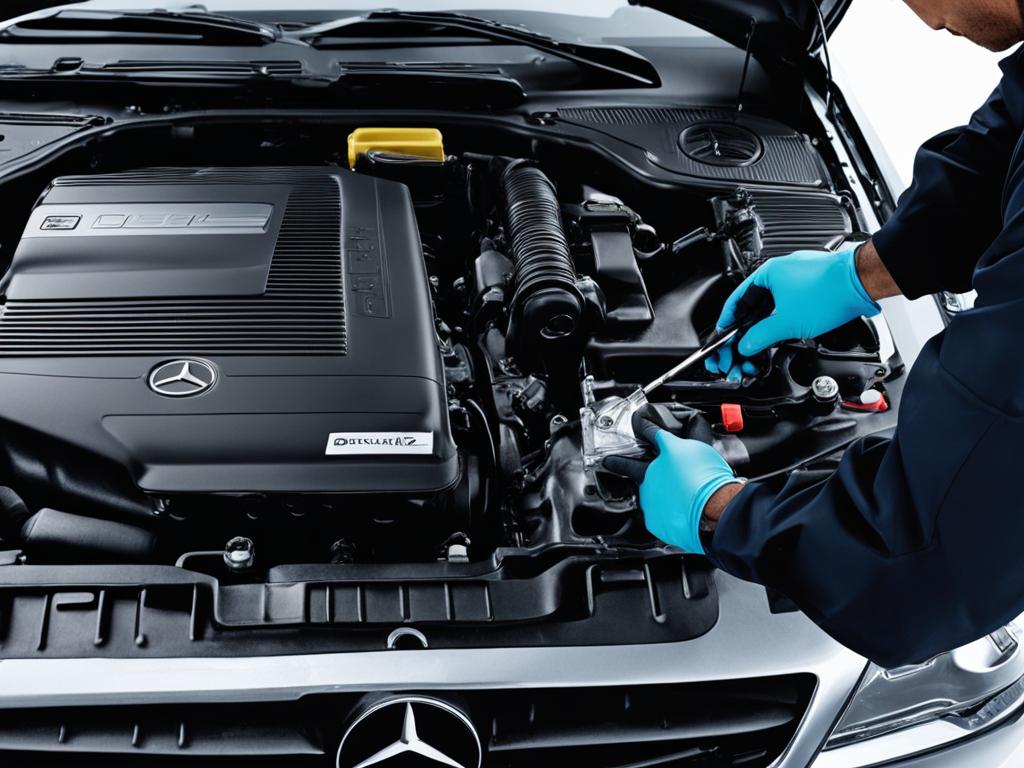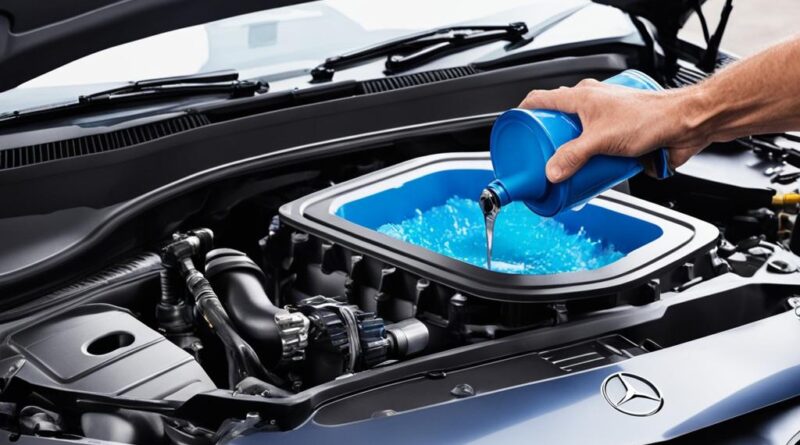Mercedes Coolant Level Check Guide – Quick Tips
Ensuring that your Mercedes vehicle’s engine does not overheat and functions at its best requires regular checks of the engine coolant, also known as antifreeze. This crucial component, composed of ethylene glycol, assists in temperature regulation within the engine during extreme weather conditions and prevents corrosion of engine components. Familiarizing yourself with the Mercedes coolant check procedure is key to maintaining your vehicle’s peak performance and avoiding costly repair from overheating.
Key Takeaways
- Understanding the importance of engine coolant
- Performing a coolant check level Mercedes step-by-step
- Properly refilling your Mercedes coolant
- Identifying and addressing coolant system issues
- Know when to contact a professional mechanic
Understanding the Importance of Engine Coolant
What separates coolant from just any liquid is its capability to moderate your car’s internal temperature, regardless of whether it’s scorching hot or freezing outside. Comprised of ethylene glycol, coolant prevents your Mercedes from succumbing to the perils of overheating by maintaining a consistent engine block temperature and protecting vital parts from corrosion. Conducting a Mercedes coolant level inspection is a proactive step toward ensuring the longevity and efficiency of your vehicle, safeguarding against the adverse effects of extreme external temperatures.
https://www.youtube.com/watch?v=Xn7REstyOUwRemember, an optimal coolant system check is essential for proper engine performance and overall vehicle health.
Mercedes engines encompass various coolant-critical components, each playing a pivotal role in temperature regulation. The table below outlines the core parts of a Mercedes coolant system and their respective functions:
| Component | Function |
|---|---|
| Radiator | Dissipates heat from the coolant, which has absorbed heat from the engine. |
| Thermostat | Regulates the flow of coolant between the engine and radiator based on the engine temperature. |
| Water Pump | Circulates the coolant throughout the engine and radiator. |
| Coolant Reservoir | Stores excess coolant for the cooling system and allows for easy coolant level inspection. |
| Heater Core | Transfers heat from the coolant to warm the cabin interior. |
Regular Mercedes coolant level checks are crucial in ensuring that all the mentioned components work harmoniously to maintain your engine’s optimum temperature. By understanding the critical role of coolant in your Mercedes, you can proactively minimize any potential engine damage and enjoy a smooth ride.
Coolant Check Level Mercedes: Step-by-Step Instructions
Performing a coolant level check on your Mercedes Benz is essential to ensure that your engine operates at optimum performance and remains protected from potential overheating. The process involves locating the coolant reservoir, assessing the coolant level accurately, and taking appropriate action if the coolant level is low. Follow these step-by-step instructions to carry out this routine maintenance task safely and effectively.

Locating the Coolant Reservoir
Your first step is to locate the coolant reservoir. This semi-transparent plastic container is connected to the radiator via a hose and features level indicators that will help you assess the amount of coolant in the system. In most Mercedes models, the coolant reservoir can be found in the engine compartment, typically on one of the sides or near the front of the vehicle. Make sure the engine is cool before attempting to check the coolant level.
Assessing the Coolant Level Accurately
Once you locate the coolant reservoir, examine the coolant level relative to the level indicators on the container. If the coolant aligns with the “full” line, your coolant level is adequate. In case you notice the level is near or below the “low” mark, it indicates your mercedes coolant level is low, and you will need to replenish the coolant. It’s essential to check the coolant level only when the engine is cool, as opening the radiator cap when hot can lead to injury from spraying coolant.
What to Do If the Coolant Level Is Low
If you find that your Mercedes has a low coolant level, you will need to top it off. First, ensure the engine is cool to avoid any risk of injury. Then, open the coolant reservoir cap and pour a premixed 50/50 ethylene glycol and water coolant solution until the level reaches the “full” mark. If you’re unsure about the compatibility of the coolant with your Mercedes, refer to the owner’s manual or consult with a professional mechanic. Regularly performing a coolant level check on your Mercedes Benz will help you identify any potential issues with the mercedes coolant level sensor or leaks within the system, ensuring the continued reliability and safety of your vehicle.
The Correct Way to Refill Your Mercedes Coolant
When faced with a coolant level warning Mercedes, it’s essential to know how to refill Mercedes coolant accurately. If your Mercedes coolant level check shows a level below the recommended mark, refilling it correctly is crucial to protect your vehicle’s engine from overheating. Follow the steps outlined in this guide to ensure proper coolant refilling:
- Ensure the engine is cool: Wait until the engine has cooled down completely before refilling the coolant. Opening the radiator cap while the engine is hot can result in injury due to sprayback from pressurized coolant.
- Prepare the correct coolant mixture: If the coolant is not pre-mixed, make a mixture of 50% ethylene glycol coolant and 50% distilled water.
- Start the engine: Turn on the engine to let it run and allow coolant to circulate properly amid the engine components.
- Fill the radiator: Carefully pour the mixed coolant into the radiator until it reaches the cap line, then securely replace the cap.
By adhering to these steps, you can prevent engine overheating issues that can arise from incorrect coolants or refill techniques. Regularly performing a Mercedes coolant level check and refilling when necessary is vital for maintaining your vehicle’s optimal performance and longevity.
| Step | Procedure |
|---|---|
| 1 | Ensure the engine is cool |
| 2 | Prepare the correct coolant mixture |
| 3 | Start the engine |
| 4 | Fill the radiator |
Remember, always be cautious while working with engine coolant and ensure your car is in a stable position with the handbrake engaged before you begin the coolant refill process.
Identifying and Addressing Coolant System Issues
Timely recognition and appropriate action is crucial in addressing coolant system issues in your Mercedes Benz. A variety of symptoms can indicate potential problems that warrant attention, ranging from low coolant levels to leaks or even engine overheating. Knowing when to tackle issues on your own and when to seek professional help is essential in maintaining your vehicle’s performance and safety.
Recognizing Common Signs of Coolant Problems
A Mercedes coolant level warning on your dashboard is an obvious indicator that you need to refill your vehicle’s coolant reservoir. Other symptoms suggesting potential coolant system issues might include a sludgy appearance of the coolant, steam appearing from under the hood, or an overheating engine. Pay attention to these signs as they can help you determine if there’s an underlying problem that requires immediate attention.
When to Contact a Professional Mechanic
If you notice your Mercedes coolant level low even after topping it off, it’s essential to contact a professional mechanic for a thorough diagnosis. Other alarming symptoms, such as white exhaust smoke or unusually firm coolant hoses, could point to a more severe issue like a blown head gasket or a malfunctioning coolant bottle level sensor. In situations like these, prompt action can prevent further damage and make a significant difference in your vehicle’s reliability and safety.
FAQ
How often should I check my Mercedes coolant level?
It is recommended to check your coolant level at least once a month or during regular vehicle maintenance such as oil changes. Also, inspect it more frequently during extreme weather conditions.
What type of coolant should I use for my Mercedes?
Use only the recommended Mercedes-Benz coolant or an equivalent that meets the specific requirements of your vehicle model. Consult your owner’s manual for the correct specifications.
Can I mix different types of coolant in my Mercedes?
Mixing different types of coolant can lead to decreased performance and potential damage to the cooling system. Always use the recommended coolant type and check for compatibility when topping off or replacing the coolant.
How do I know if there’s a leak in my Mercedes coolant system?
Signs of a coolant leak may include low coolant levels, visible puddles underneath the vehicle, a sweet odor, or a sludge-like appearance in the coolant. If you suspect a leak, consult a professional mechanic for a proper diagnosis and repair.
What should I do if my Mercedes is overheating?
If your Mercedes is overheating, pull over to a safe location as soon as possible and turn off the engine. Allow the engine to cool, and check the coolant level. If necessary, top off the coolant and consult a professional for diagnosis and repair of the underlying issue.




